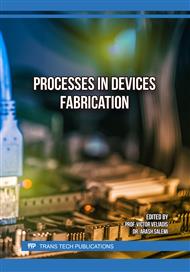[1]
G.S. May and C.J. Spanos, Fundamentals of Semiconductor Manufacturing and Process Control, Hoboken, NJ: John Wiley & Sons (2006).
Google Scholar
[2]
Xiao Hong, Introduction to Semiconductor Manufacturing Technology, Prentice Hall Inc., New Jersey, USA (2001).
Google Scholar
[3]
M. Tamura and H. Sunami, Jpn. J. Appl. 8, 1097 (1972).
Google Scholar
[4]
C. -L. Hung, B. -Y. Tsui, C.-P Shih, IEEE Transactions on Electron Devices, vol. 69, no. 10, pp.5742-5748 (2022).
Google Scholar
[5]
B. -Y. Tsui, T. -K. Tsai, Y. -T. Lu, J. -H. Lin, C. -L. Hung and Y. -X. Wen, in IEEE Transactions on Electron Devices, vol. 68, no. 12, pp.6644-6647 (2021).
Google Scholar
[6]
J. -C. Cheng and B. -Y. Tsui, in IEEE Transactions on Electron Devices, vol. 65, no. 9, pp.3739-3745 (2018).
Google Scholar
[7]
Lanni, L., Malm, B. G., Östling, M., & Zetterling, C. M. (2014). Materials Science Forum, vol. 778–780, Trans Tech Publications, Ltd., Feb. 2014, p.1005–1008.
DOI: 10.4028/www.scientific.net/msf.778-780.1005
Google Scholar
[8]
K. Kawahara, M. Krieger, J. Suda, and T. Kimoto, Journal of Applied Physics, vol. 108, no. 2, p.023706 (2010).
Google Scholar
[9]
T. Kimoto and J. A. Cooper, Fundamentals of Silicon Carbide Technology: Growth, Characterization, Devices, and Applications, John Wiley & Sons Singapore Pte. Ltd (2014).
DOI: 10.1002/9781118313534
Google Scholar
[10]
T. Dalibor, G. Pensl, H. Matsunami, T. Kimoto, W. J. Choyke, A. Schöner, and N. Nordell, Phys. Status Solidi A 162, 199 (1997).
DOI: 10.1002/1521-396x(199707)162:1<199::aid-pssa199>3.0.co;2-0
Google Scholar
[11]
Thomas Dalibor, Gerhard Pensl, Tsunenobu Kimoto, Hiroyuki Matsunami, Shankar Sridhara, Robert P. Devaty, Wolfgang J. Choyke,Diamond and Related Materials,Volume 6, Issue 10 (1997).
DOI: 10.1016/s0925-9635(97)00108-8
Google Scholar
[12]
Katsunori Danno, Tsunenobu Kimoto, J. Appl. Phys. 15 May 2007; 101 (10): 103704.
Google Scholar
[13]
K. Agarwal, S. Seshadri and L. B. Rowland, in IEEE Electron Device Letters, vol. 18, no. 12, pp.592-594 (1997).
Google Scholar
[14]
O. Aviñó-Salvadó, B. Asllani, C. Buttay, C. Raynaud and H. Morel, in IEEE Transactions on Electron Devices, vol. 67, no. 1, pp.63-68 (2020).
DOI: 10.1109/ted.2019.2955181
Google Scholar
[15]
R. Waters and B. V. Zeghbroeck, Appl. Phys. Lett., vol. 76, no. 8, p.1039 (2000).
Google Scholar


